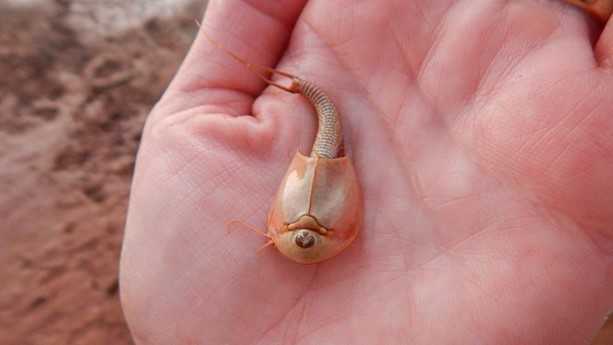February 15, 2024

Image credit: L.Carter/NPS
Scrolling down my Edge browser I came across a video posted on Live Science explaining the hundreds of tadpole-like creatures that appeared after heavy rain. Officials at Arizona’s Wupatki National Monument reported hundreds of prehistoric creatures had hatched from eggs in a temporary lake in the desert landscape. Lead ranger Lauren Carter said the creatures look like mini-horseshoe crabs with three eyes. Their appearance was first reported by tourists who saw them in a temporary, rain-filled lake within the ceremonial ball court at the monument. The court is a circular walled structure about 35 yards (32 m) across. Carter knew the monsoon in late July had filled the ball court with water but did not expect anything living in it. She first assumed these were tadpoles from toads who live in burrows during the dry season. When Carter scooped one up, she noticed a familiarity with reports of a creature when she had worked at Petrified Forest National Park in northeastern Arizona called a Triops. The Central Michigan University said the dinosaur shrimps’ eggs could lay dormant in the desert for decades until adequate rain falls make a lake to provide habitat for the eggs to hatch, mature, and lay eggs for the next generation.
When I went online, I found the American tadpole shrimp (Triops longicaudatus), or longtail tadpole shrimp or dinosaur shrimp, is a freshwater crustacean of the order Notostraca, resembling a miniature horseshoe crab. The shrimp is characterized by an elongated, segmented body, a flattened shield-like brownish carapace covering two thirds of the thorax, and two long filaments on the abdomen. The genus name Triops comes from Greek “ops”, meaning “eye” prefixed with Latin tri- or “three”, and refers to the animal’s three eyes. Longicaudatus is an Latin neologism combining longus (“long”) and caudatus (“tailed”) and refers to the long tail structures. Triops are found in freshwater ponds and pools, often in places where few higher forms of life can exist. Triops are usually greyish yellow or brown in color and differ from many other species by the absence of the second maxilla (mouth parts). As the name suggests, the elongated tail structures (cercopods) are often nearly as long as the rest of the body. The species (with the cercopods) may reach 3.0 inches (75 mm) long.
Triops’ appearance has changed little since the group emerged in the Devonian period (419 million to 359 million years ago). This ancient and morphologically consistent lineage has led some to call the creatures “living fossils” or dinosaurs, a term that is also used to describe deep-sea coelacanths (fish of the order Coelacanthiformes) and horseshoe crabs (order Xiphosura). Because their water habitats are temporary, they mature quickly and go from eggs to breeding adults in two to three weeks. Triops are hermaphrodites (each has both sexual organs), but they can reproduce sexually and even produce offspring from unfertilized eggs (unisexual). This flexibility in reproduction helps each generation of Triops raise the next, even in extreme environments like the Arizona desert. Triops’ eggs can enter a state of dormancy where the eggs stop developing and dry out (diapause). Diapause allows the eggs to survive when their pools evaporate. The eggs can stay in diapause for up to 27 years waiting for water to return so they can hatch. This is a long wait to become alive.
THOUGHTS: While the cicada may live underground for up to 17 years, that is different than the 27 years of diapause that may occur with the Triops. Diapause is observed in all the life stages of arthropods, especially insects, and embryonic diapause (delayed implantation) is a reproductive strategy used by more than 130 types of mammals and possibly humans. In mammals the pre-embryo (blastocyst) does not immediately implant in the uterus but remains in a non-dividing state of dormancy until conditions allow for attachment to the uterine wall to proceed. This may also result in a long wait to be alive. Act for all. Change is coming and it starts with you.